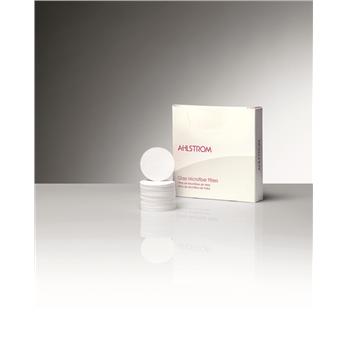$ 78.08
Details
Additional Info Ahlstrom offers a full range of glass microfiber filters manufactured from 100% pure borosilicate glass. Because of their intrinsic properties, glass microfiber filters have wide applications in many areas of laboratory analysis, especially when fine filtration and high loading capacity is required. Applications for Ahlstrom glass microfiber filters include environmental analysis for water, wastewater, testing of soils, air pollution and monitoring, research and process biochemistry, and gravimetric analysis involving ignition of samples. Ahlstrom glass microfiber filters are also found in the filtration of hot gases and liquids, and in pre-filtration.Laboratory analysis100% pure borosilicate glassRapid flow rateFine particle retention 0.7µm – 3.1 µmHigh loading capacityChemical and thermal resistance (up to 500°C)Long shelf lifeBrilliant white color reflecting more than 96% of visible lightCustom cutStandard Glass Microfiber FiltersStandard glass microfiber filters contain no binders or other additives that may cause interference to sensitive enzymatic or other chemical reactions. The unique characteristics of glass microfiber filters make its use particularly advantageous to laboratory filtration by enabling fast filtration of large volumes and difficult solutions without premature clogging.Ahlstrom 161: 1.1µm – Medium SpeedThis popular grade offers finer particle retention and higher flow rate than traditional analytical filter papers. Ahlstrom 161 is used in general laboratory applications, cell harvesting, liquid scintillation counting, and in the monitoring of air and water pollution. Ahlstrom 161 is generally recommended for water pollution monitoring techniques for total suspended solids.Environmental Laboratory Applications:STM 2540 Total, Dissolved, Suspended, Fixed and Volatile Solids (Mining Laboratory Application also)Test method for the measurement of matter suspended or dissolved in water or wastewater. These solids analyses are important for the control of biological and physical wastewater treatment processes and for assessing compliance with regulatory agency effluent requirements.STM 2710.B,D,E Tests on Sludges: Oxygen-Consumption Rate, Sludge Volume Index, Zone Settling Rate (Mining Laboratory Application also)Each of these tests requires the suspended solids concentration to calculate the property of interest. This value is determined via STM 2540.STM 3500-Fe Iron Detection: Phenanthroline MethodDuring digestion of samples containing organic interferences, the solution may need to be filtered through a glass fiber filter.STM 4500-P.C Phosphorus in Water: Vanadomolybdophosphoric Acid Colorimetric MethodDuring sample preparation a glass fiber filter may be used as a pre-filter before the membrane filter. Grade 161 is suitable. Activated carbon is mixed into the test solution to remove interfering elements. The carbon is then filtered out using Grade 94, which will not impart any contaminates to the filtrate and will retain all the activated carbon.STM 5910 UV-Absorbing Organic ConstituentsThis method to indicate the total level of organic compounds of various types in a sample of water.STM 7110.C Gross Alpha and Gross Beta Radioactivity: Coprecipitation MethodA glass fiber filter, such as Grade 161, is used to collect the precipitate formed in this test so that the radioactive count can be measured.STM 8111 Biostimulation (Algal Productivity)During separation of unialgal test species, the sample is filtered through a glass fiber pre-filter, such as Grade 161, and a membrane filter.40CFR60 App A Method 5 – Determination of Particulate Matter Emissions from Stationary Sources (Mining Laboratory Application also)Air emissions are sampled over a set amount of time through a glass microfiber filter, such as Grade 161, maintained at a temperature of 120ºC. The mass of particulate matter deposited on the filter is then analyzed gravimetrically. The low mineral content, high reflectance, chemical resistance, loading capacity and heat resistance makes this the ideal media for this test.40CFR60 App A Method 17 – Determination of Particulate Matter Emissions from Stationary Sources (Mining Laboratory Application also)This method is used instead of Method 5 when the amount of particulate matter is considered independent of temperature. With the thermal requirement eliminated, Grade 111 becomes the better recommendation because it has a higher throughput than Grade 161 while maintaining the necessary low mineral content and chemical resistance.40CFR62 Method 201 – Determination of PM10 Emissions (Exhaust Gas Recycle Procedure)This method for analyzing air emissions is used when the particulate matter of interest is 10 microns or less. A cyclone collector separates the particles and the fine ones are captured by Grade 161 and the mass determined by gravimetric analysis.Construction Laboratory Applications:ASTM 2042-09 Solubility of Asphalt Materials in TrichloroethaneAn asphalt sample is washed with Trichloroethane to remove the soluble portion of the sample. The insolubles are collected on the surface of a binder-free glass Grade 161. The residue and filter are then dried, and the insolubles, gravimetrically determined.Ahlstrom Environmental Technical BulletinAhlstrom Grade 161 TDS


